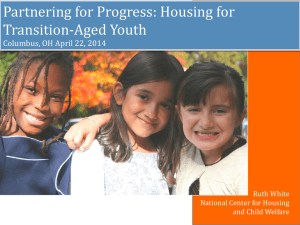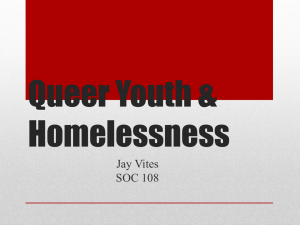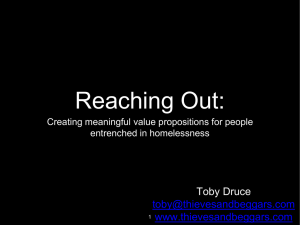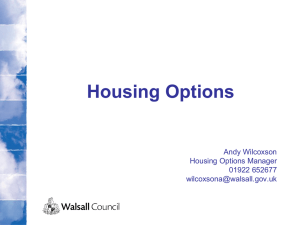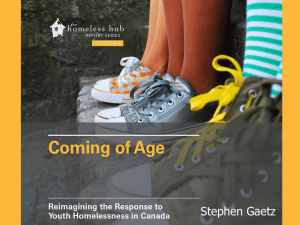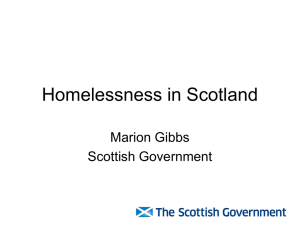I can*t say who I am unless you agree I*m real.
advertisement
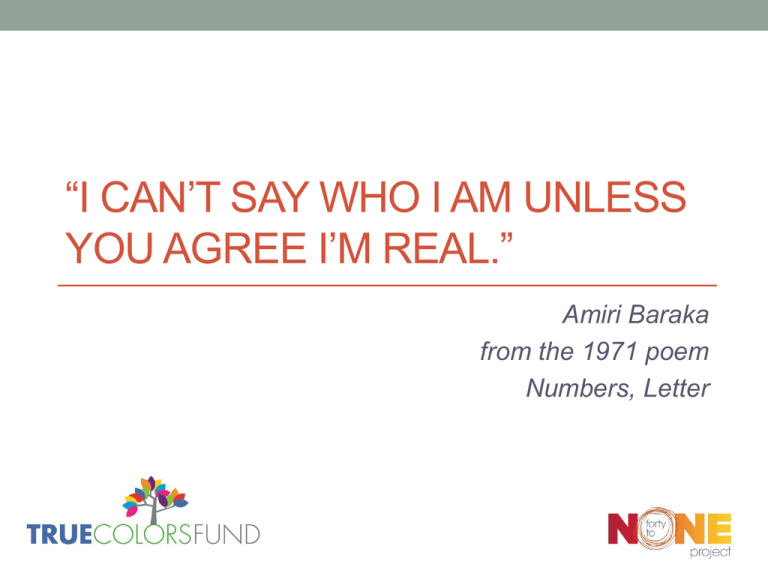
“I CAN’T SAY WHO I AM UNLESS YOU AGREE I’M REAL.” Amiri Baraka from the 1971 poem Numbers, Letter THE ISSUE What is the most frequently cited reason for LGBTQ youth homelessness? • a. Aging out of foster care • b. Lack of affordable housing options • c. Identity based family rejection Top Five Reasons why LGBT Youth are Homeless or At-Risk of Becoming Homeless Ran away because of family rejection of sexual orientation… 46% Forced out by parents because of sexual orientation or… 43% Physical, emotional, or sexual abuse at home Aged out of the foster care system Financial or emotional neglect from family 32% 17% 14% Majority of LGBT Homeless Youth Get Help from Non-LGBT Specific Providers LGBT Specific 24% Mainstream 76% Percent of Service Providers who Served any LGBT Clients, Over Time 100% 90% 80% 70% 60% 50% 40% Ten Years Ago LGB Five Years Ago In the Past Year TRANSGENDER LGBT YOUTH: FALLING THROUGH THE CRACKS DROP-IN & SHELTER • Youth Fear Unsafe Programs • Family & Community Rejection TRANSITIONAL LIVING PROGRAM • Employment Barriers • Non-Affirming Policies/Procedures PERMANENCE • Lacking Safety Net • Lacking Permanent Connections • Lacking Adequate income INITIATIVE BACKGROUND Initiative Background • Rationale • Overarching purpose o Prevent homelessness for LGBTQ youth at risk of becoming homeless o Intervene early to quickly end homelessness for LGBTQ youth • Key objectives 1. Facilitate local collaboration and plan development and implementation 2. Inform national strategies to prevent LGBTQ youth homelessness 3. Facilitate use of USICH Framework to End Youth Homelessness and community focus on USICH core outcome areas Initiative Background • Grounded in collaboration among partners • Federal agencies: o U.S. Departments of Education, Health and Human Services, Housing and Urban Development (lead agency), Justice o U.S. Interagency Council on Homelessness • Non-federal partner: True Colors Fund • Technical assistance: American Institutes for Research, National Center on Family Homelessness (lead); Center for Social Innovation; HomeBase, The Center for Common Concerns • Expectations around funding • Timing • Importance of sharing results Initiative Progress • 12 communities considered and ranked; 2 selected based on criteria such as strength of local continuum of care: o Hamilton County (Cincinnati), Ohio o Harris County (Houston), Texas • 6-month collaborative local strategic planning process completed o Local lead agencies o Steering committees and subcommittees established o Assessment of strengths and needs o Grounded in core outcomes including stable housing, permanent connections, education and employment, and well-being • Process for completing plans: plan organization Organization of Planning Teams Cincinnati • Awareness Building & • • • • • Cultural Competence Child Welfare Housing & Transportation Options Organizational Policy & Data Practices Practical Living/Life Skills Social & Emotional Support Houston • • • • • • • • • • • Advocacy Child Welfare Criminal Justice Education & Training Employment Funders Primary & Behavioral Health Care Research & Data Schools Shelter & Housing Resource List Intended Outcomes and Impacts • Stable Housing • Permanent Connections • Education and Employment • Well-being • Systems Change Strategies & Activities Cincinnati • Awareness Building & • • • • • Cultural Competence Child Welfare Housing & Transportation Options Organizational Policy & Data Practices Practical Living/Life Skills Social & Emotional Support Houston • • • • • • • • • • • Advocacy Child Welfare Criminal Justice Education & Training Employment Funders Primary & Behavioral Health Care Research & Data Schools Shelter & Housing Resource List Early Reflections 1. Follow the initiatives of Cincinnati and Houston 2. Do not reinvent the wheel (work from resources like the USICH framework) 3. Review available research and data and assess needs/strengths (e.g., interviews, surveys) 4. Be mindful of trauma and its effects on youth and families 5. Engage strong local leaders, or those who have the potential to be so, and develop their capacity further Early Reflections 6. Develop a shared vision 7. Be strategically collaborative—think about who to 8. 9. 10. 11. engage, when, why, and how Engage local philanthropy early on Assess and measure what works—and how and why (continuous quality improvement) Engage youth and families in your planning and implementation Be bold—be prepared to learn, adapt, and innovate Early Reflections 12. Act quickly to address this crisis—there is not time for a lengthy planning process. 13. The challenge of a geographically large initiative (county wide). 14. The value of branding. 15. Communications and media engagement. Next Steps • Local plan implementation • Delivery of technical assistance to support local implementation • Communications plan implementation • Evaluation—what we expect to learn o Documentation of local approaches o Measurement of change and understanding of successful practices • Dissemination to support awareness in the field and replication in other communities WHY NOW? • Federal plan to end youth homelessness by 2020 • Runaway and Homeless Youth & Trafficking Prevention Act • Youth Inclusion in PIT counts • National visibility and support • True Colors Fund’s Forty to None Project • The National Coalition for Homeless Youth COMMUNITY INNOVATIONS • Nashville, TN o LaunchPad • Miami, FL • Collective Impact community planning • iCount • Seattle/King County • Count us in (Youth Count) • Ruth Ellis Center • Child Welfare, RHY, Family intervention (similar to FTIP)

